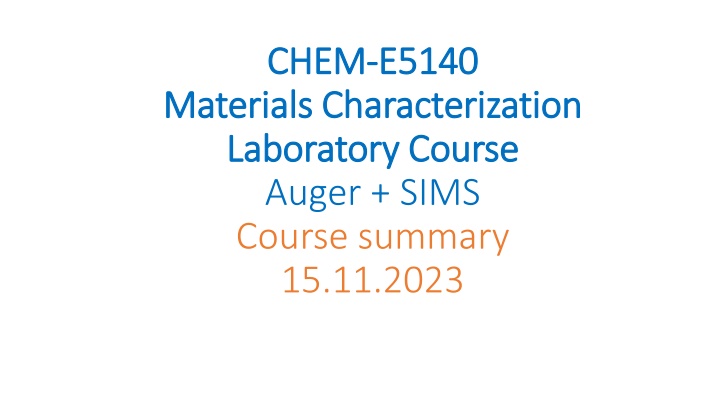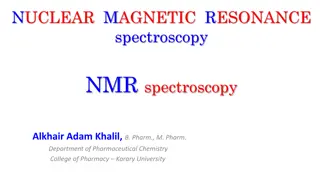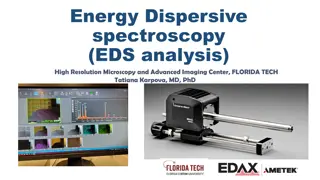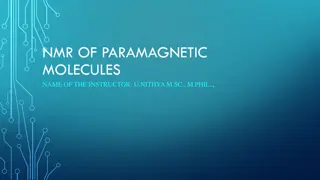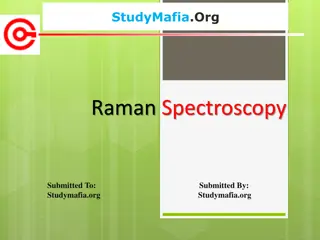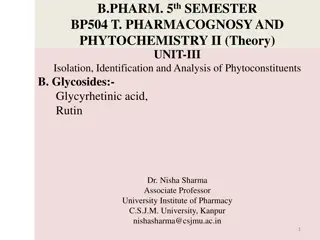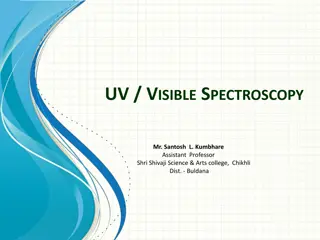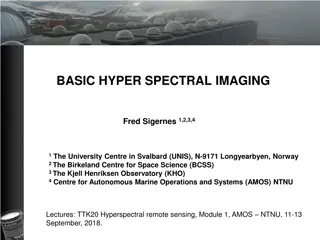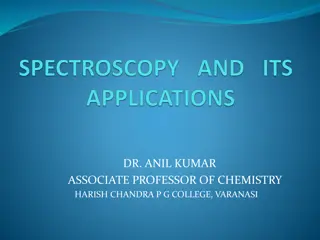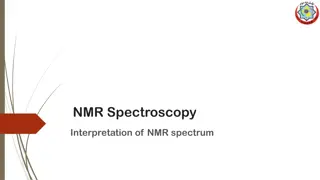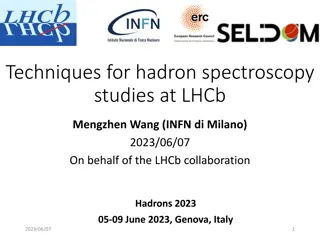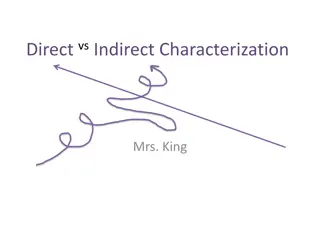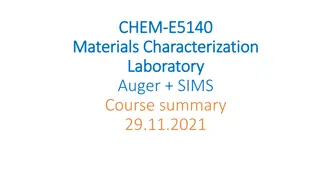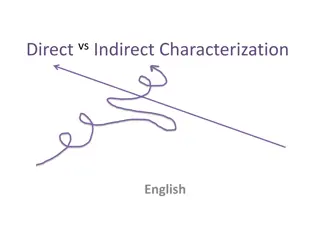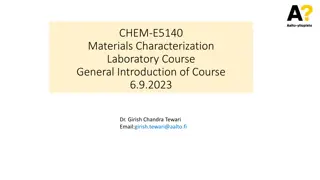Auger Spectroscopy: Techniques and Applications in Materials Characterization
Auger spectroscopy, named after Pierre Auger, is a powerful technique for analyzing the surface composition of materials at the atomic level. This method involves the emission of Auger electrons and characteristic x-rays upon interaction with an electron beam. It offers high surface sensitivity, enabling the detection of only a few monolayers of material. The terminology of Auger electron transitions and their probabilities are crucial in interpreting the data obtained. Overall, Auger spectroscopy plays a significant role in the field of materials characterization, providing valuable insights for research and development.
Download Presentation

Please find below an Image/Link to download the presentation.
The content on the website is provided AS IS for your information and personal use only. It may not be sold, licensed, or shared on other websites without obtaining consent from the author.If you encounter any issues during the download, it is possible that the publisher has removed the file from their server.
You are allowed to download the files provided on this website for personal or commercial use, subject to the condition that they are used lawfully. All files are the property of their respective owners.
The content on the website is provided AS IS for your information and personal use only. It may not be sold, licensed, or shared on other websites without obtaining consent from the author.
E N D
Presentation Transcript
CHEM CHEM- -E5140 Materials Materials Characterization Characterization Laboratory Laboratory Course Auger + SIMS Course summary 15.11.2023 E5140 Course
Auger Spectroscopy Auger electrons were named after Pierre Auger who, together with Lise Meitner, discovered Auger electron emission in 1920s. Leng, Yang. Materials Characterization : Introduction to Microscopic and Spectroscopic Methods, John Wiley & Sons, Incorporated, 2013. ProQuest Ebook Central, http://ebookcentral.proquest.com/lib/a alto- ebooks/detail.action?docID=1333091. Created from aalto-ebooks on 2018-11- 26 01:42:43. E. Haimi, SEM lecture
EDS Characteristic x-rays Incident electron beam hits the surface Produces core-level vacancy Relaxation of the ionised state by emission of an x ray photon Detection of an x ray W.R. Runyan, T.J. Saffner, Semiconductor measurements and instrumentation, McGraw Hill, 2nd Ed. 1998, Chapter 14.
Auger spectroscopy Auger electron emission The relaxation of the ionized state by an Auger electron
Auger electrons Rare event 1 Auger electron for every 1 000 secondary electrons (SEM) -> development for a special detectors Auger transition is more probable with light elements starting Li -> Observes well C, N and O Are often also contaminants Requires ultra high vacuum (UHV) W.R. Runyan, T.J. Saffner, Semiconductor measurements and instrumentation, McGraw Hill, 2nd Ed. 1998, Chapter 14.
Auger electron terminology Auger electrons originated from different electron shells are labelled with three letter: ABC A = initial ionization shell B = replacement electron shell C = Auger electron shell Most probable are KLL, LMM, MNN W.R. Runyan, T.J. Saffner, Semiconductor measurements and instrumentation, McGraw Hill, 2nd Ed. 1998, Chapter 14.
High surface sensitivity Incident electron beam 3 -5 keV Auger electrons are adsorbed into the solid sample Only few monolayers detected > High surface sensitivity W.R. Runyan, T.J. Saffner, Semiconductor measurements and instrumentation, McGraw Hill, 2nd Ed. 1998, Chapter 14.
Auger equipment The cylindrical mirror analyser Applied negative voltage for the outer plate Inner plate to ground Applied a voltage ramp by time Maximize the detection of Auger electrons
Auger spectroscopy What can I analyse? Samples When interested of the outer most monolayers on a surface Interest of light elements Or contamination (organic) Samples need to tolerate and be suitable for ultra high vacuum! Is non-destructive, however, needs sample preparation, so often the sample is lost
Surface cleaning Sputter etching Only few monolayers, often we have organic impurities Ionized inert gas (Ar+) with focus beam of 3-5 keV The removal rate of material ~10 nm per minute W.R. Runyan, T.J. Saffner, Semiconductor measurements and instrumentation, McGraw Hill, 2nd Ed. 1998, Chapter 14.
Surface cleaning Sputter etching Example of AlGaAs:SF6 Having S and F impurities + organic contamination (C,O) After sputter etching, the peaks of Ga, As and Al more visible Also a small indication of Ar W.R. Runyan, T.J. Saffner, Semiconductor measurements and instrumentation, McGraw Hill, 2nd Ed. 1998, Chapter 14.
Data analysis A derivative display is used to help in the characterization Data obtained from the experiment - Has high background of secondary electrons W.R. Runyan, T.J. Saffner, Semiconductor measurements and instrumentation, McGraw Hill, 2nd Ed. 1998, Chapter 14.
Secondary Ion Mass Spectroscopy SIMS Ions are also charged particles (like electrons) Can be deflected with electric or magnetic field Focused small ion probe at the sample surface Incident ions are capable to knock of secondary ions
SIMS Provides Detection of All element (also H and other light ones) Different Isotopes Detection for one to two most top atomic layers (< 1 nm) Detection of elements in Concentration as low as 10-6 possible [Auger and XPS 0.1 at%] Many of the non Charged products -> can not be detected
Instrumentation Ultra high vacuum needed Electromagnetic lenses Y. Leng, Materials Characterization : Introduction to Microscopic and Spectroscopic Methods, Publisher, Wiley-VCH
SIMS Ions Large mass O- ion 10 000 more mass than electron Can be destructive for the surface Sand blaster Ions commonly used Ar+, Xe+, O2+, Ga+, Cs+ Y. Leng, Materials Characterization : Introduction to Microscopic and Spectroscopic Methods, Publisher, Wiley-VCH
SIMS Is the method destructive? Method still under development [especially data analysis] - > qualitative method (currently) Two different modes of operation Dynamic SIMS Destructive High flux of primary ions (sputtering) Similar to Auger and XPS Static SIMS Non-destructive Low flux of primary ions [changing the analysis place] Y. Leng, Materials Characterization : Introduction to Microscopic and Spectroscopic Methods, Publisher, Wiley-VCH
SIMS Not a measure of mass but rather mass to charge ratio Sensitive Very little background Depth of 1-2 nm (from surface) Ppm or Ppb detection limits Qualitative technique Boron doped Silicon Y. Leng, Materials Characterization : Introduction to Microscopic and Spectroscopic Methods, Publisher, Wiley-VCH
SIMS Analysis Mass-to-charge ratio Individual ions Ion clusters Molecular fragments Spectrum of positive or negative ions More complex than(Auger/XPS), more peaks Y. Leng, Materials Characterization : Introduction to Microscopic and Spectroscopic Methods, Publisher, Wiley-VCH
Course summary The first lecture 6.9.2023 Imaging Method SEM OM TEM AFM Elemental Analysis TEM (Crystal) EDS Raman XPS Auger SIMS Surface properties XPS (roughness) AFM SEM SIMS Other knowledge
The techniques for the exam Scanning Electron Microscopy(SEM), Four Probe Resistivity and Hall, X- ray Diffraction (XRD), Raman Spectroscopy, Atomic Force Microscopy(AFM)
Oral Exam First task Describe a method All the methods learned at the course are in my doctoral hat you will take one with randomly picking (chit in which the method will be mentioned) and answer to questions: 1. What does the method provide and how does it work? (0-4 p.) 2. What kind of samples can be analysed? (0-4 p.) 3. What could a possible result look and how is it analysed? (0-6 p.) + Additional points possible (2 p.)
Oral Exam Second task A case study: Real case (from a published paper):A material has been created 1. How the sample is synthesized (0-2p) 2. What methods are used to characterization and why? (0-8 p.) 3. Explain the data (0-8 p.) 4. Your own idea about characterization (enough (Why ?) or need more ? If need what method could be used and why ? (0-2 p)
Exam practice Case: Al and Ti co-doped zinc oxide (ATZO) nano-structured thin films with 1 at % Al and 0.1 at % Ti were deposited on glass substrate via sol gel technique. How would you analyse?
Exam practice Interpretation of the following data What does it tell to you? Fig. 1 Al Ti co-doped ZnO (ATZO) thin film (a) and JCPDS card number 89-1397 (b) [standard hexagonal ZnO] . What method?
Fig. 2. ZnO (a), Al dobed ZnO (AZO) (b), ATZO thin films (c) and the cross-sectional image of the ATZO thin film (d).
Fig. 3. Surface roughness and grain size of the ZnO, AZO and ATZO thin films.
